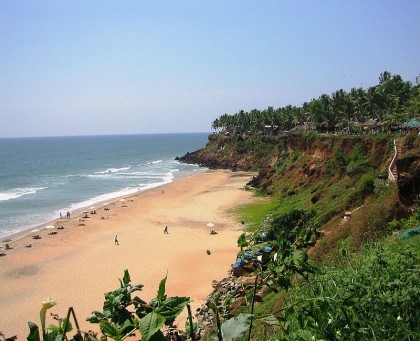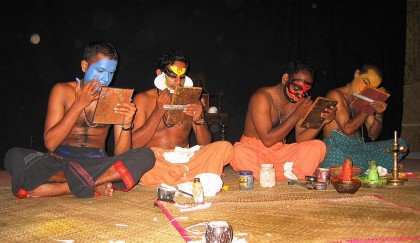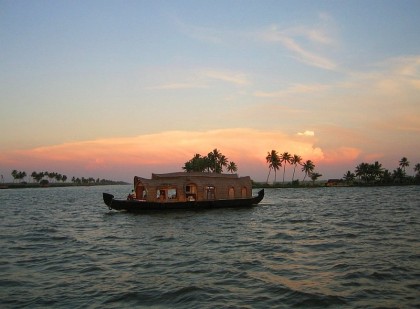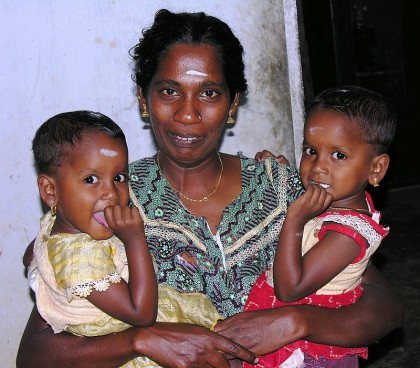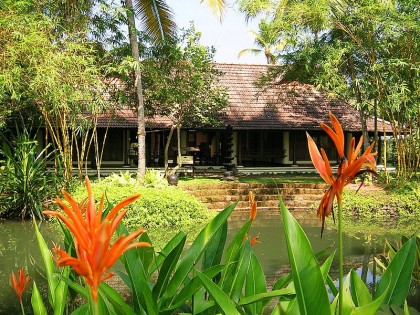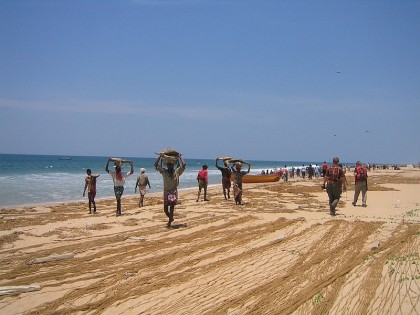
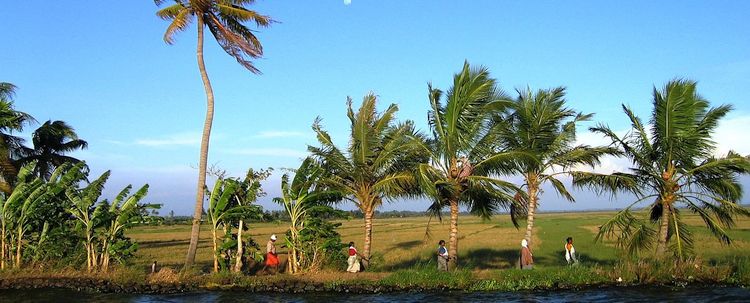
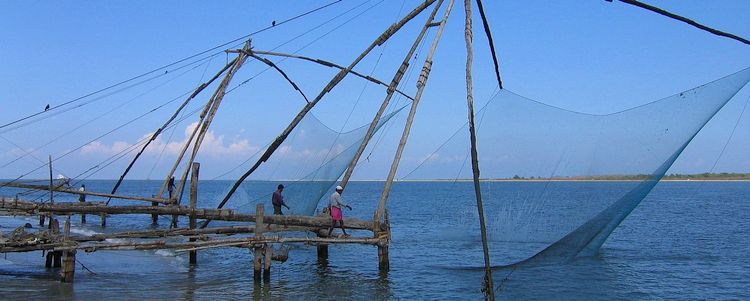
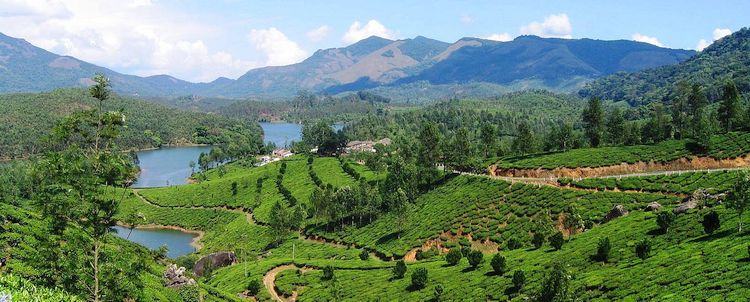
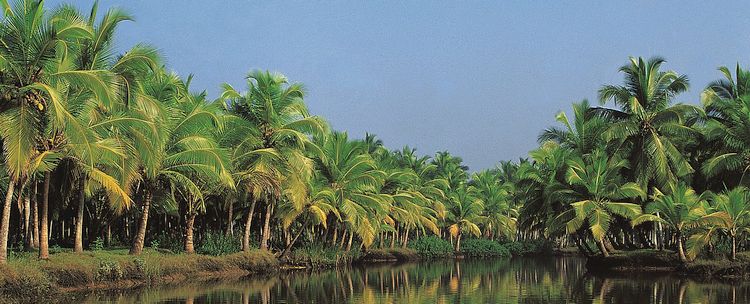
Kerala – the Tropical Garden of India
Best Travel Period | Kerala in Brief | Peoples and Religions | Food | Flora and Fauna | National Parks and Nature Reserves | History | Economy | Festival Calendar
From the mysterious, peaceful backwaters across the exotic spice gardens to the charming mountain scenery with its sprawling tea gardens, Kerala will captivate you with its emerald green, water-rich and picturesque landscapes and with the friendly people in their colorful dresses.
The south of India offers to the visitor a rich mosaic of impressions: tropical forests, lush plantations, wide sandy beaches and ancient customs and practices embedded in their traditional culture form. In contrary to the north of the country, the distant location of South India saved it throughout the past centuries to a large extent from Muslim invaders. Countless temples and cultural monuments reflect the splendor of large Hindu kingdoms, and are a testimony to religious traditions and an outstanding artistic temple construction. Until today, traditional festivals are celebrated, whose important component in front of this historical backdrop is the temple dance Kathakali, which represents one of the oldest expression of an art form in the world. The masked performers combine music, dance, literature, drama and even painting to a captivating performance, which you should not miss under any circumstances during your holiday in Kerala.
The backwaters, an extensive, predominantly natural canal system, that connects many lakes which are full of fish and other water bodies to each other, can be wonderfully explored by boat. While you gently glide past on the waterways, the South Indian everyday life takes place on the banks: Indian women do their laundry, stylishly and colorfully dressed in saris, pupils in their school uniforms are traveling to or from school, and tireless fishermen throw out their nets. Experience the beautiful nature in the "land of coconuts" with all your senses, and follow the course of the backwaters. In a canoe or during several days in the comfort of the traditional houseboats, the "Kettuvallams", you will discover the waterways of Kerala.
The journey through the fascinating landscape of the backwaters of Kerala with their almost incalculable system of lagoons, rivers and canals with an overnight stay on the boat is an unforgettable experience. After an impressive round trip, exclusive spa and ayurveda resorts or a stay at one of the extensive beaches of Kerala, invite to rest and relaxation. Millennia-old Indian teachings are the foundation for the holistic treatments according to Ayurveda, yoga and other applications, which will enhance your well-being in an long lasting manner. In the very good wellness resorts and spas in Kerala, highly qualified therapists see to it, that you forget the hectic of everyday life. With pleasure we will integrate Ayurvedic treatments according to your wishes, our offers range from effective, individual wellness applications up to Panchakarma detox treatments, which go on over several weeks.
Watch the fascinating Indian wildlife in Thekkady, another scenic highlight in Kerala. Surrounded by the National Park of Periyar, luxurious resorts offer proximity to the diverse flora and fauna of the tropical rainforest, whose original beauty could be preserved. Thanks to the respectful interaction of the people with nature, you can get to see species here like the endangered Bengal tigers, elephants, macaques, Nilgiri tahr, gaurs, sambars, fish otters and mongooses, not to mention countless exotic species of birds.
Experience the lush green jungle and the fragrant tea plantations in Munnar, and embark on a journey through picturesque vast landscapes. Here you learn to recognize and enjoy the subtle nuances of different teas, get an insight into the long tradition of tea culture of India, and let yourself get carried away, by the impressive views over the countryside ,from the daily grind, into the deep relaxation of a rejuvenating holiday.
Our travel packages combine some of the most beautiful places there are to visit in the region. Your personal wishes are for us of utmost importance! Excursions and activities are mostly carried out using a private vehicle, with optional two-day boating holiday, but also cycling and hiking tours are being offered.
Best Travel Period
The best time to visit Kerala is from September to early April, but even during the monsoon season from June to August prevails in Kerala mostly good weather. The temperatures range throughout the year between 25 ° and 33 ° Celsius. The warmest it is in April and May, when temperatures from 28 ° - 34 ° C are being reached. Since the climate in Kerala is tropical, there may be unexpected rain on a daily basis. There are years when the monsoon is completely absent, and there are years when it rains for several days in the middle of the dry season.
Bathing in the sea is usually possible from the fall over the New Year to mid-May; from mid May to late August, bathing is generally not allowed, because of the high waves, and the sea water pools of the hotel facilities are a safe alternative.
Kerala in Brief
| Location | On the southwest tip of India by the Arabian Sea on the so- called coast of Malabar, with borders to the states of Karnataka and Tamil Nadu. |
| Area | 38.863 km² |
| Population | 33.387.677/ 859 per km² (2011) |
| Capital | Thiruvananthapuram |
| Districts | 14: Alappuzha, Ernakulam, Idukki, Kannur, Kasaragod, Kollam, Kottayam, Kozhikode, Malappuram, Palakkad, Pathanamthitta, Thiruvananthapuram, Thrissur and Wayanad. |
| Topography | Kerala has an around 590 km long coastline, to which adjoins a flat strip of land, with initially with a maximum width of 120 km, which is crossed by inland waters. In the East, the Western Ghats rise with an average altitude of 1500 m above sea level. The highest point is the Anamudi with 2695 m above sea level. |
| Vegetation | In the mountains of the Western Ghats in the west of the state, evergreen and semi-evergreen moist forests (balsam trees, for example Canarium strictum, plants of the mallow family such as Dipterocarpaceae and Bombacaceae, angiosperms like Bischofia javanica, magnolias, bamboo, ferns, orchids and lianas ); the flat coastal strip is used predominantly for agriculture, and has hardly any natural vegetation left. Along the estuaries and the widely branching system of water bodies of the backwaters, a little mangrove forest, otherwise sandy beach with coconut trees and low bushes and grasslands. |
| Wildlife | The original fauna of Kerala is mainly preserved in the conservation area of Periyar, because of the heavy agricultural use of the land surface (86%). Here lives the Bengal tiger, Indian leopard, elephant, and sambar, gaur, mongoose, fish otter, beard- and many other species of monkeys; besides around 320 different species of birds, 45 reptiles and almost 30 different species of amphibians; countless fish, and of course a very wide variety of insects. |
| Climate | Tropical monsoon climate |
| Temperatures | Constant temperatures between 25 and 33 ° C, peak temperature up to 34 ° C in April and May. |
| Precipitation | 5000 mm of rainfall per year in the mountainous regions, 1250 mm in the coastal area. Richest rainfall in the monsoon season from June to October. |
| Languages | Malayalam (97%), Tamil (2%), as well as Konkani; Tribal languages Tulu and Koraga. English is educational and economic language. |
| Ethnicties | Malayali (97%), less than 1% of indigenous people like the Koraga. |
| Religions | 56 % Hindus, 24 % Muslims, 20 % Christians |
| Economy | Mostly agriculture and fishing, and processing industry of the products, little chemical industry and IT. ¾ of the gross domestic product is created in the service sector, the most important growth area is tourism. |
| Getting there | International airports: Kochi, Calicut and Trivandrum; or arrival by domestic flight from Mumbai, Delhi or other domestic airports. |
| Visa / Entry permit | For an entry to India, a passport which is valid for at least another six months, and a visa are required. |
| Vaccinations | Hepatitis, typhoid fever, rabies, Japanese encephalitis, malaria prophylaxis. |
Peoples and Religions
For Indian conditions exists in Kerala a particularly evenly distributed mixture of religions. Even if the Hindus, with more than 56% make up the majority of the faithful here too, there is a disproportionately large number of Muslims (24%) as well as Christianity, which is represented above average by about 20% of the faithful. This is because the people in the region entered into trade relations very early and permanently with the Arabs, and then the colonization by the Portuguese and Dutch, which was taking place a few centuries later.
However, it is - as almost everywhere in India – that here these three great religions also succeeded to live for centuries in harmony and on equal footing. The homogeneity of the ethnic background is another extreme of Kerala. As different as the religions are, as uniform are origin and language in the country. Almost all the inhabitants are descendants of the peoples of the early principalities, and 97% of people speak the dialect formed historically here, Malayalam, making these common origins audible to the present day.
Almost exclusively in the north of the province still live members of the tribe of other indigenous peoples and speakers of the Tulu, Konkani and of the Koraga languages. The people of Kerala are friendly and outgoing, and draw from their religious diversity the greatest benefits. Whole cities are transformed into colorful fairgrounds when one of the great Hindu, Muslim or Christian holidays is being celebrated, and the cultural openness enriches everyday life.
Food
Thanks to the fertile soil a wide variety of fruits and vegetables could always be produced in Kerala, which of course had a great influence on the development of the traditional dishes. Also the use of a wide range of seafood made for a varied diet. The trading with Arab countries, which was established already before the Middle Ages, then did the rest to enrich the menu, and the variety of recipes of traditional Kerala cuisine even further.
During the period of the colonial powers finally even European influences found their way into the kitchens of the country. Overall, the cuisine of Kerala can nevertheless be described as typically Indian, and curry dishes with rice as a side dish dominate the everyday diet. But to name as a special feature is certainly the for Hindu countries uncharacteristically frequent use of meat and dairy products in the recipes, that can be attributed to the Arab and European influences, and the current high proportion of Christian believers in Kerala.
As everywhere in India one has to remember that in Kerala, for one, no uncooked and / or unpeeled fruit and vegetables should be consumed, on the other hand, it is recommended to match the degree of spiciness of the food to the individual taste and tolerability. Even desserts - in Kerala, for example, a dessert which is prepared of rice cakes with coconut, cashew and raisins, which absolutely should be tried! - may appear too sweet for the European palate. Nevertheless, the variety offered is so enticing that you should definitely give in to it one time.
Flora and Fauna
Due to the strong agricultural use of the land area (about 85%), the original flora and fauna of Kerala is obtained almost exclusively in the Periyar Nature Reserve in the mountains of the Western Ghats. The semi- evergreen rain forests, which were formerly widespread in the mountainous region, had to give way to tea and spice plantations almost everywhere. Accordingly, the diversity of the wildlife has declined significantly - which is, thinking of the occurrence of absolutely dangerous species, not always to be evaluated negatively.
The coastline was historically not as thickly overgrown and full of animals as the mountain regions. Here one finds today only sporadically some mangroves, which dig their immense, high roots into the muddy grounds of the riverbanks. A magnificent, charming postcard idyll produce fairly widespread coconut trees along the sandy beaches, where otherwise there is a fairly sparse vegetation. Wild mammals one encounters in the shallow coastal region little, but the colorful butterflies and the always audible birdsong fills the air here in an exotic way.
National Parks and Nature Reserves
Whoever makes vacation in Kerala should travel in any case to the Periyar National Park near the town of Thekkady. The protected area, which extends over almost 800 square kilometers, including the wonderful Periyar lake, and is situated at an altitude of 100-2019 meters above sea level, contains large biodiversity. The plant's wealth lies mainly in the up to 50 m high, evergreen and semi-evergreen moist forests of sal and hollyhocks trees, magnolias, bamboo and many other trees and shrubs, which are often overgrown with orchids and lianas. In this dense jungle hide - unfortunately also from the eyes of the tourists - successfully the threatened Bengal Tiger and the equally rare Indian Leopard.
The noisy monkey hordes (here lives among many others the endangered lion-tailed macaque Macaca silenus) dominate the treetops, but do not stop at the treeless areas. Here visitors have many opportunities to watch animals like Asian elephants, sambars (horse deer) Rusa unicolor, gaurs (large cattle), Bos gaurus and Nilgiri tahrs Nilgiritragus hylocrius for example, at the daily visit to the watering hole. Mongooses and fish otters are somewhat more difficult to spot, however, also exist in large numbers, in the Periyar National Park. Ornithologists will enjoy sightings of around 320 different species of birds.
Especially exotic are the hornbill and parrot species, but also woodpeckers and passerines live here in with us not native species. Also to be found are various hens and waterfowl, as well as impressive birds of prey. The exotic variety is supplemented by reptile species, which one can also get lucky enough to see while sunbathing. However, whether you want to meet one of the many snakes like king cobra or Russell’s viper, is another question. Adorable in any case, is the variety of butterflies that silently populates the air; Experts and friends of Lepidoptera can hope for sightings of around 160 different species.
History
Kerala belongs to the areas of India, which were only settled comparatively late. This is primarily attributable to the here predominant, extremely dense jungle, which could be made arable and habitable only with relatively highly developed technologies. Although there are definitely earlier references to cities on the territory of today's Kerala, history is documented from about 400 AD. At that time the kings of different tribes ruled, like the Mooshikas, the Cheras and the Ays. Again and again, however, their kingdoms were subject to attacks of neighboring nations, so that the domination changed relatively frequently.
The tribe of the Cheras could assert itself the longest, which had, with interruptions, until the year of 1102 a particular region of present-day Kerala under its control. Subsequently, the Kingdom of Venad was probably the most important and also the largest in the historical sequence, successful trade relations with both Arab and with European nations are resulting from this time. Venad was until the arrival of the later colonial rule the major economic power in the region. With the landing of Vasco da Gama in 1498, reached first a new wave of armed conflicts today's Kerala, which only with the withdrawal of the Arabs from the region gave way to a fragile peace.
In 1662 finally the Dutch colonial power took over, and several Indians inherited the formal title of the king of the once so impressive kingdom of Venad. In 1791 entered one of the then reigning princes of the region into an alliance with the British, after previously the Dutch could be driven out from many cities. The now new situation was that the principalities were only formally independent under British colonial rule. This ended in 1947 with the Indian independence. Since 1956, the democratically ruled state of Kerala exists within its present borders.
Economy
Most of the people in Kerala work in agriculture (about 85% of the land is in agricultural use) or in fishing, and even if the income from the cultivation of rice, coconuts, rubber, betel and cashew nut, tea, coffee, cocoa and spices (partly also in processed form) include a considerable volume of exports, only about a quarter of the gross domestic product is being generated within this sector. The by far largest part of the economic returns of the country result from the service sectors, which in turn is based to a large extent on tourism, and still shows promising growth rates. Not only because of the beautiful coastal landscapes and the interesting cultures which attract tourists, but also thanks to successful and future-oriented measures from government side, Kerala belongs to the richer states of India, and has a successful health and education system.
Festival Calendar
The festivals of the Hindus are determined by the lunar calendar, which is why they take place annually at different dates. Whether a festival day with particularly interesting cultural program falls in your travel window, we will gladly discuss personally with you! Due to the prevalence of Islam and Christianity in Kerala, of course also the festival days which are typical for these religions are being celebrated. Especially recommended, and during a vacation in Kerala almost a must, is certainly the visit to a Kathakali festival. This dance, which combines elements of acting in addition to music, is the oldest in southern India existing dance form, and a cultural form that can be called characteristic for Kerala. Certainly we could integrate a visit to a Kathakali event into your journey - we will gladly advise you!

